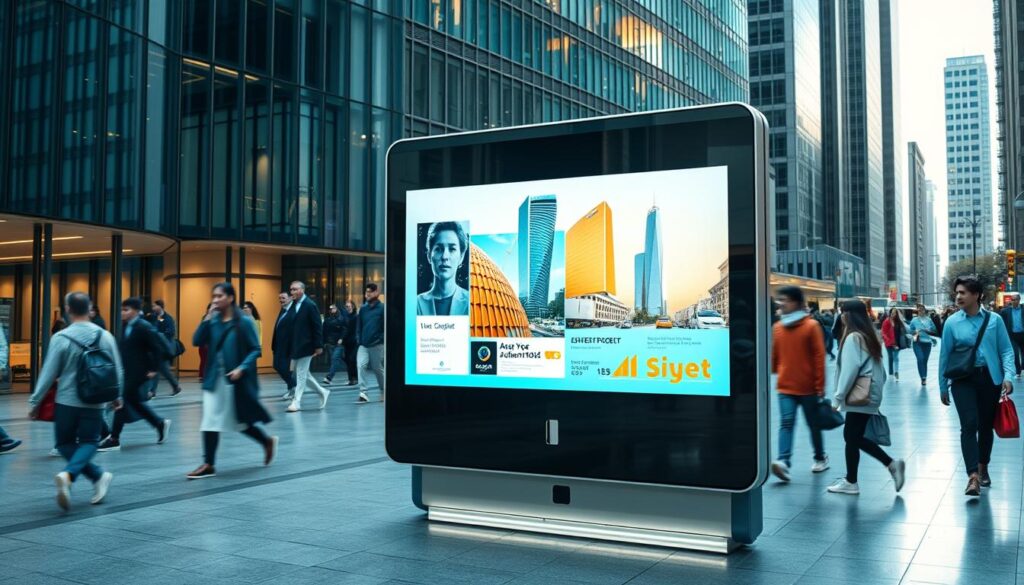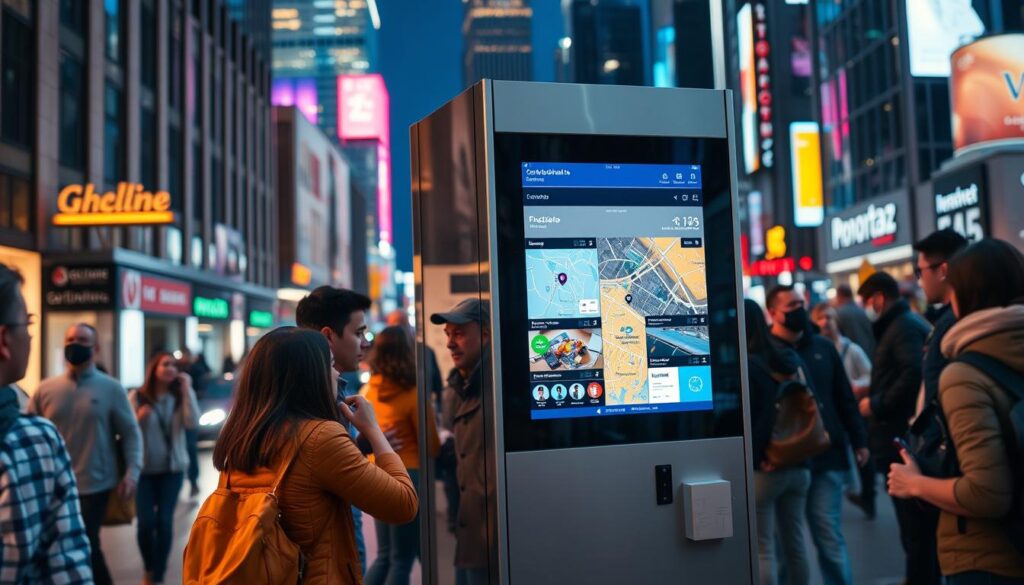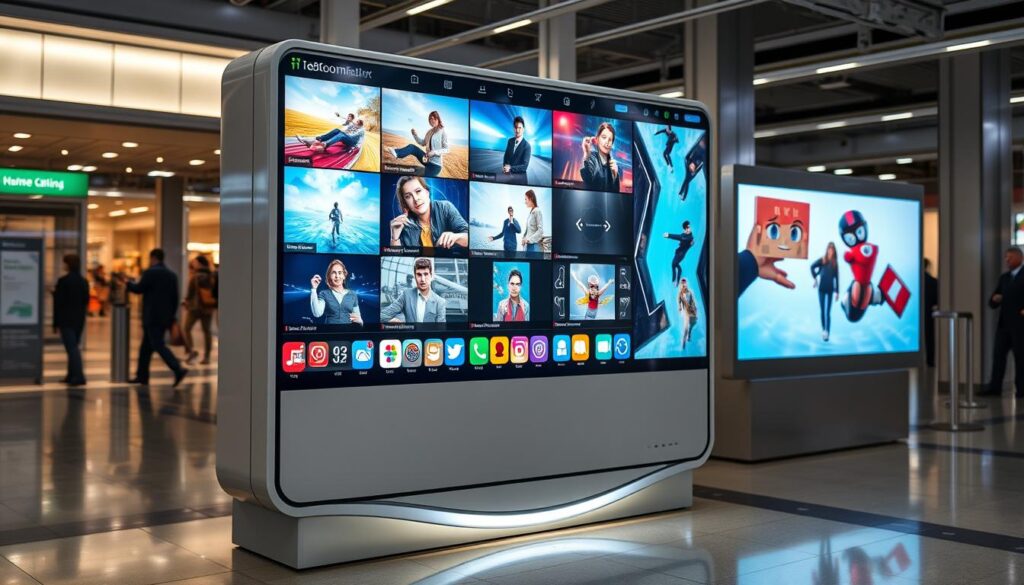Digital signage kiosks are changing how businesses talk to their customers. They have big touchscreens and work like traditional kiosks but look like digital signs. The market for these kiosks is growing fast, expected to hit $11.5 billion by 2027.
These kiosks give customers a personal experience, cut down wait times, and work all day, every day. They are key for better customer service and smoother operations. They can show off products, help with self-checkout, and share important info.

Key Takeaways
- Digital signage kiosks are getting more popular across many industries, with a focus on interactive displays for better customer interaction.
- They help increase sales and brand awareness by showing off products, deals, and ads well.
- Strong Content Management Systems (CMS) let businesses plan when to show content and make playlists, keeping viewers interested.
- Kiosks with Digital Signage have many ways to connect, making it easy to add more features.
- They also have top-notch security, like biometric checks and encrypted data, to protect against damage, theft, and unauthorized access.
Understanding Digital Signage Kiosk Technology
Digital signage kiosks are now everywhere, making wayfinding and self-service easier. They use interactive touchscreens to engage users. These systems combine many parts to offer great experiences.
Components and Core Technologies
A digital signage kiosk has a display screen, like LCD or OLED. The screen’s size, resolution, and brightness matter. It also has a media player, computer, and mounting hardware for connectivity.
Display Types and Screen Technologies
The display is key in a digital signage kiosk. Small kiosks have 7-15 inch screens, while medium ones are 15-32 inches. Larger screens over 32 inches are used for big displays. These screens show high-definition images for clear messages.
Interactive Features and Capabilities
Digital signage kiosks are interactive. They use touchscreens for gestures like swiping. They can also connect to IoT devices and AI for more features.
These technologies together help businesses create better interactions. They improve user experiences and meet marketing goals.
Benefits and Advantages of Digital Kiosk Implementation
Digital signage kiosks bring many benefits to businesses and their customers. They improve audience engagement, make communication smoother, and share information better. This leads to more sales and better brand awareness.
One big plus of digital kiosks is how they grab customers’ attention. 75% of customers are more likely to shop in a store with interactive displays. By showing products and deals in an exciting way, businesses can draw in more people and get them to look around.
These kiosks also help with customer service and satisfaction. 40% of consumers prefer self-service over human contact. They offer a quick and easy way for customers to get info, buy things, and solve problems. This cuts down wait times and makes customers happier, leading to 90% of consumers being willing to pay more for personalized services.
Also, digital kiosks are great for retail digital signage and public information systems. They let businesses update content quickly and manage it from afar. This keeps the info up-to-date and relevant, keeping customers interested and loyal to the brand.
What’s more, digital kiosks give businesses valuable data. They can learn about customer behavior and preferences. In fact, data-driven companies are 23 times more likely to gain customers and 19 times more likely to be profitable.
In summary, digital kiosks offer many benefits. They boost audience engagement, improve communication, save costs, and provide useful data. As businesses try to stay ahead and meet changing customer needs, using these innovative tools can be a big advantage.
| Benefit | Statistic |
|---|---|
| Increased customer engagement | 75% of customers are more likely to shop in a store with interactive displays |
| Improved customer satisfaction | 40% of consumers prefer self-service over human contact |
| Personalized services | 90% of consumers are willing to pay more for personalized services |
| Data-driven decision making | Data-driven companies are 23 times more likely to gain customers and 19 times more likely to be profitable |

“Digital kiosks offer a turnkey solution that can significantly enhance the customer experience and drive business growth.”
Essential Features for Successful Digital Signage Deployment
Creating effective digital signage needs a smart plan. It includes good content management, strong security, reliable hardware, and easy connectivity. These parts work together to make digital signage engaging, safe, and efficient for businesses and their viewers.
Content Management Systems (CMS)
A strong Content Management System (CMS) is key for digital signage success. It makes managing content easy, letting businesses schedule, customize, and update their multimedia content without hassle. This keeps the information current, relevant, and right for the audience engagement.
Security and Hardware Requirements
Keeping digital signage kiosks safe and durable is essential. They should have designs that resist tampering, use biometric authentication, and send data securely. Businesses also need to pick high-quality hardware that can handle frequent touchscreen interfaces and weather well, ensuring their digital signage lasts long and works well.
Connectivity and Network Infrastructure
Good connectivity is vital for smooth content delivery and remote management. Digital signage kiosks should have Wi-Fi, Ethernet, and cellular options for reliable communication and updates. A strong network helps data flow smoothly, allowing for quick updates and remote fixes for a responsive digital signage setup.
“Over 40% of shoppers state that digital signage can drive them to purchase a product.”
By using these key features, businesses can make a dynamic, engaging, and secure digital signage experience. This experience will grab the audience’s attention and make operations smoother.

Guide to Digital Signage Kiosk Applications Across Industries
Digital signage kiosks are used in many industries, changing how businesses talk to customers and make things easier. In retail, they act as virtual salespeople. They help with self-checkout, show product details, and offer virtual dressing rooms for a better shopping experience.
In healthcare, kiosks help with patient check-in, finding your way, and telemedicine. This makes the patient experience better. The hospitality industry uses them for easy hotel check-in and out, tourist info, and event tickets. This makes service smooth and efficient.
In banking and finance, kiosks offer ATM services and info on financial products. Airports and other transport hubs use them for ticket sales, route info, and self-check-in. This makes travel easier and more convenient. Other areas like education, corporate, entertainment, manufacturing, and outdoor ads also use kiosks. They improve communication, make things run better, and give customers a great experience.
FAQ
What are digital signage kiosks and how do they work?
Digital signage kiosks are interactive displays with large touchscreens. They mix traditional kiosk functions with digital signage’s visual appeal. These kiosks use screens, media players, and network connections to offer engaging experiences.
What are the core components and technologies used in digital signage kiosks?
Digital signage kiosks have several parts. These include screens like LCD, LED, or OLED, media players, and mounting hardware. They also have network connections. Interactive touchscreens, like capacitive or infrared, make them easy to use.
What are the key benefits of implementing digital signage kiosks?
Digital signage kiosks bring many advantages. They improve customer engagement and communication. They also boost sales and brand awareness. Plus, they make customer service faster and more efficient.
They help reduce wait times and support multiple languages. They can also update content quickly.
What are the essential features for successful digital signage kiosk deployment?
For a successful deployment, a strong Content Management System (CMS) is key. It makes managing and updating content easy. Security, durable enclosures, and quality components are also important.
Reliable connectivity and a solid network are needed for smooth content delivery. This ensures real-time updates.
In what industries are digital signage kiosks being used?
Digital signage kiosks are used in many fields. These include retail, healthcare, and hospitality. They are also used in banking, finance, and transportation.
They are found in education, corporate settings, entertainment, and manufacturing. They serve as virtual sales assistants and provide information. They enhance customer experiences overall.